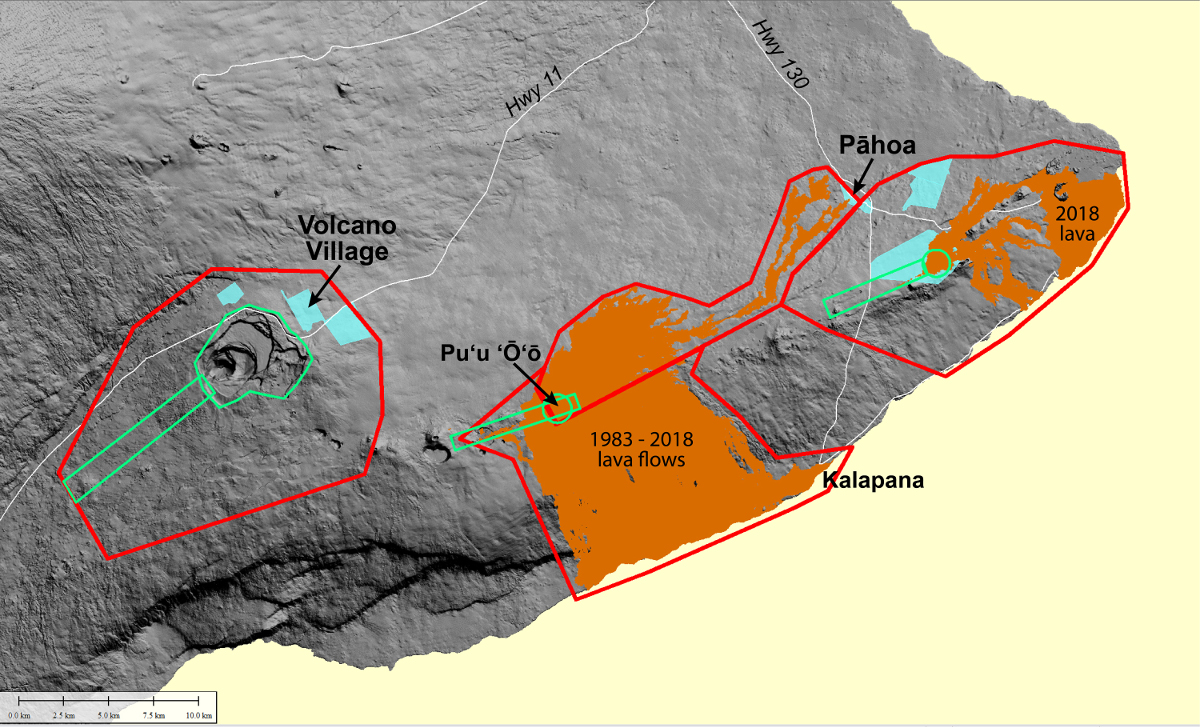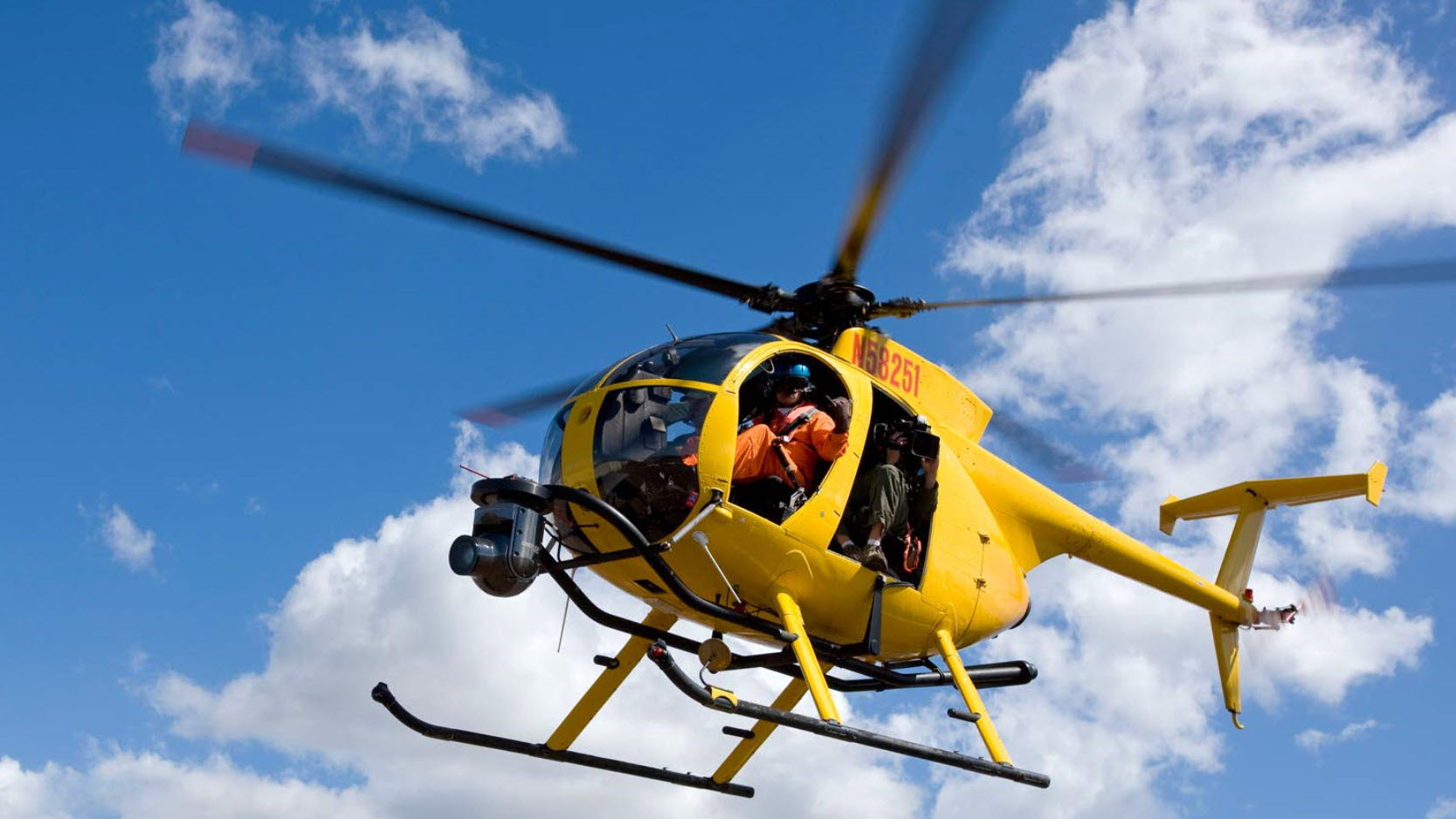
Areas on Kīlauea that will be covered by a helicopter lidar survey in June 2019. Red lines enclose areas over which the survey helicopter will fly at 396 m (1,300 ft) above ground level. Green lines enclose areas over which the helicopter will fly at 151 m (500 ft) above ground level. USGS map.
(BIVN) – Scientists are planning to survey Kīlauea Volcano from its summit to Kumukahi, while the volcano is quiet.
Kῑlauea Volcano is not erupting and its U.S. Geological Survey Volcano Alert level remains at NORMAL/GREEN.
In this week’s Volcano Watch article, USGS Hawaiian Volcano Observatory scientists and affiliates write about the upcoming survey effort.
Since the end of 2018’s volcanic activity, USGS Hawaiian Volcano Observatory scientists have wanted to resurvey Kīlauea Volcano’s ground surface to document changes brought about by the Puna eruption and summit collapse. Doing so would allow us to more accurately answer questions about the total volumes of erupted lava and summit subsidence that occurred last summer.
By detailing these changes, it could also facilitate recovery and long-term risk mitigation projects by local partner agencies. A new survey would also allow comparison to earlier digital elevation data sets acquired by both helicopter lidar (Light Detection and Ranging) and by UAS (unmanned aerial systems) imagery during Kīlauea’s 2018 eruption.
We are happy to announce that our desire to resurvey Kīlauea will soon become a reality. The precision of this new survey will improve the accuracy of those earlier data sets.
The data will be acquired by a bright yellow helicopter flying over much of Kīlauea’s summit and East Rift Zone at an altitude of 396 m (1,300 ft) above ground level (agl). The aircraft will fly in a lawn-mowing pattern, back and forth in a northeast-southwest direction. A few smaller areas on Kīlauea, namely parts of the East Rift Zone (Leilani Estates, Ala`Ili Rd, and Puʻu ʻŌʻō), the upper Southwest Rift Zone, and the summit caldera, will be flown at a lower altitude of 152 m (500 ft) agl.
These helicopter flights are currently planned for the period of June 13 to June 30, 2019, weather permitting.
The survey will use lidar technology capable of sending out hundreds of laser pulses per second. This should allow coverage of at least 30 laser pulses per square meter (ppsm), or about 3 pulses per square foot. The lower elevation flights will allow coverage of at least 100 ppsm, or about 9 pulses per square foot.
Why collect the lidar with such high-resolution? It’s the best way to detect and map vertical or near-vertical features, and there are a lot of them—from ground cracks everywhere, to fissures in the lower East Rift Zone (LERZ) and caldera walls at Kīlauea’s summit. High-resolution lidar is the best way to document and measure these potentially hazardous features.
A helicopter, rather than a fixed-wing aircraft, will be used for the survey because it can fly slower and acquire high-resolution lidar. The helicopter can also work even if there is high-altitude cloud cover.
The new lidar surface from this survey can be used to model where new lava flows may travel if renewed volcanic activity occurs in the LERZ. From an emergency management perspective, having these models was important during Kīlauea eruption responses in 2014-2015 and 2018.
The bare-earth elevation model (digitally stripped of all vegetation) is the main interest of geologists because it will reveal geologic features such as faults and cracks that are not yet mapped. However, the lidar point cloud data from which it is derived will also contain other data, such as vegetation type and density. This could be a goldmine for biologists mapping flora on Kīlauea.
To illustrate the power of lidar, in a USGS 8 ppsm lidar survey of Glacier Peak volcano in Washington, it is possible to differentiate between maple, alder, and fir trees in the vegetation points. Blackberries at the edges of open areas can also be detected. In California, lidar surveys are used to catalog vegetation that could fuel forest fires.
Along with lidar data, the helicopter will simultaneously collect 4-band digital imagery (red-green-blue, or RGB, plus near-infrared). These multispectral images will also be useful to help detect geologic features and classify vegetation.
The final products of this survey, a digital elevation model and detailed imagery covering surveyed areas, will be made public and should be available by late 2019.
We understand that helicopter noise can be disruptive, so we will greatly appreciate affected residents’ patience and understanding as we collect this extremely important data to help mitigate future lava flow hazards. The survey should take only 8-10 days, weather permitting, to complete.


by Big Island Video News5:51 pm
on at
STORY SUMMARY
HAWAIʻI ISLAND - Scientist are set to resurvey Kīlauea Volcano after the 2018 eruption on the lower East Rift Zone and the dramatic collapse events at the summit.